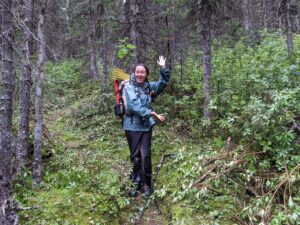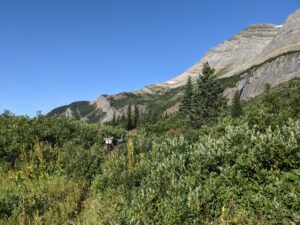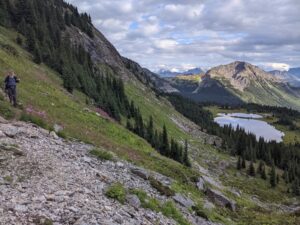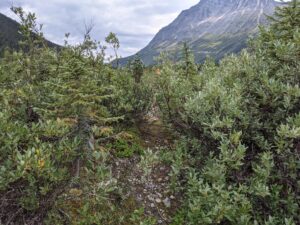by Eloise Robbins
“It is the worst hiking I’ve ever done in my life,” the southbounder complained, a soft accent masking the fatigue in his voice. “It took me all day just to get between camps. Terrible. Alders up to here.” His hand hovered over his head. This awful section of trail, which had him so shaken up? The Jackpine River, infamous among thru-hikers as the very worst section of bushwhacking on the entire Great Divide Trail.
A dirty smudge covered his cheek, and one pant leg was ripped from ankle to knee. To be fair, we didn’t look any better. We’d stopped for the night at Chown Horse Camp, north of Mount Robson. We only had a week left to hike the final kilometers of the Great Divide Trail, but we were struggling. The trail had gotten steadily worse after leaving Jasper. I’d torn a hole in my pants clambering over downed trees, and alders and willows had blocked the path for most of the past week. We’d spent the day fording swollen rivers past the remnants of washed out bridges. And apparently it was about to get even worse.
We left camp in the morning, saying goodbye to our new friend. We crossed Chown Creek over and over, until our feet went numb in the glacial water. We climbed up towards Bess Pass, blood rushing back to our feet in painful pins and needles. We crossed another valley, then up, up, up, across the trailless wilderness of the Jackpine Alpine to Blueberry Lake. Glacier-studded mountains ringed the high plateau, while streaks of virga rained down from patchy clouds.
We set up camp at Blueberry Lake, cooking dinner in the lee of a few stunted pines. Dusk fell, turning the snow streaked peaks pink with alpenglow. Exhausted, we were about to turn in when we heard voices. Three figures emerged from the trees, carrying a strange, electronic box.
“Northbound? You’re in for a treat!” One of the figures greeted us. “We just got done with the Jackpine Valley. Cleared a bunch of brush. Once you hit Spider Creek, it’s smooth sailing.”
The trail crew stayed for a while, chatting with us about our hikes and what we could expect from the next section. As the first stars popped out overhead, they wandered off to set up the trail camera they carried, and return to their tents for the night.
We rose early, anxious to get a head start on the Jackpine. After we crossed another pass, the trail descended steeply, the way frequently blocked by fallen pines. Blueberries the size of grapes lined the trail: a reward for the tough travel. We reached the river, following a rough animal track through alders that wound together above my head, forming a tunnel that blocked out the building clouds above.
We forded the river, again and again, trying to stay on horse paths that were little more than faint indentations in the vegetation. The trail crew had given us hints on the easiest travel, and told us to cross the water whenever the path petered out. We couldn’t get too lost: we just had to follow the river as it meandered down the valley. But our way was frequently blocked by impenetrable vegetation, thick as a wall. Occasionally, we had no choice but to put our heads down and push through, stems as fat as my wrist grabbing at my clothes, and wet leaves whipping my face as they sprang back from my husband pushing through in front of me.
I checked my phone constantly. Not because I was worried about getting lost, but because I was counting down the kilometers to Spider Creek. Just a few hundred meters away, and the clouds that had been building all day burst. Thunder boomed and echoed across the valley, loud as a rockslide. We took refuge in a stand of pines on the banks of the Spider. Across the river, we could see a trail badge, white and shiny and new. We’d made it.
After half an hour, the storm moved off. Soaked and grumpy, we searched for the trail. The blaze was right there. But where was the trail? Surely it must be obvious? We traipsed back and forth searching, wet rain gear sticking to our skin, until we shivered from the damp. Finally, we gave up, bushwhacking towards the river. In this narrow valley, we’d find the path eventually, right?
Two kilometers later, and I’d given up completely. The trail maintenance was a lie. We’d be stuck in bushwhacking hell forever. There was no escape. I thought about resigning myself to my fate and lying down on the side of the river. The only problem was that there wasn’t a single square inch that wasn’t covered in these damn alders.
Then, appearing like a dream, a single cut stem, the white sapwood broken and bright against a ring of dark bark. Underfoot, green leaves were trampled into the mud. Another broken shrub, and then another, until the trail was lined with cut leaves and torn branches. It wasn’t pretty: the trail crew had hacked and cut with speed and violence rather than precision. But after fighting through the brush for days, I too would have taken great pride in whacking back at the bushes.
In an instant, we picked up speed. We went from a half a kilometer an hour crawl to flying down the river valley. We didn’t need to wonder where the trail went: cut branches showed the way. I didn’t need to put my head down and push through woody stems, and not a single branch smacked me in the face. After being drenched from the carwash effect of wet branches, my rain gear finally began to dry.
We followed the cut bushes all the way to Big Shale Hill. Every time we crossed what had formerly been a particularly thick patch of brush, we’d thank the trail crew out loud. “Thank you trail crew!” my husband sang out as we walked through sawdust surrounded a cut log that would have blocked the trail a few days ago. “Thank you trail crew!” I called while following neon flagging where a burn had obliterated the trail. The smell of cut pine gave the trail a festive feel, and my husband sang Christmas carols as he followed me up towards the crest of Big Shale through the fog. Trail maintenance was the best present we could have received.
I’ve never hiked a trail as dynamic as the GDT. You can see how much it’s changing in every blaze, every cut tree, or reroute to avoid a dirt road. We bumped into two separate trail crews in 1,100 kilometers. On my entire AT thru-hike, a much more popular trail three times as long, I didn’t see a single crew. You can feel how well loved this trail is as you hike it. You can tell there’s an entire group of people supporting it, figuring out how to make it better.

I’ve heard from friends who hiked a few years ago just how hard the GDT used to be. Sure, it’s still plenty challenging now, but you can see just how much the trail has improved. If it wasn’t for the work of volunteers, we might still be fighting against the alders in the Jackpine.
So, on behalf of all thru-hikers past, present, and future, thank you. Thank you if you joined a trail crew this summer. Thank you if you’ve cut a log or flagged a route in the past. Thank you if you’re watching the GDTA website intently, waiting for opportunities to volunteer next summer. Thank you if you donated money so others could get out there and clear a path. Thank you if you volunteer behind the scenes, raising money or doing admin work. We said it out loud to your work on the trail this summer, but now I want to say it to your face. Thank you.




